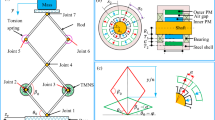Abstract
When using robots for heavy loads and huge operating ranges, elastic deformations of the links have to be taken into account during modeling and controller design. Whereas for conventional rigid multilink industrial robots modeling can schematically be done by standard techniques, it is a massive problem to obtain an accurate analytic model for multilink flexible robots. But an accurate analytic model is essential for most modern controller design techniques, and modeling errors can lead to instability of the controlled system due to spillover since the eigenvalues of the system are only slightly damped. A new approach to active damping control for flexible robots is presented in this paper where the actuators act like virtual spring-damper-systems. As the spring-damper-element is a passive energy dissipative device, it will never destabilize the system and thus the control concept will be very insensitive to modeling errors. Basically, the two parameters, spring stiffness and damping constant of this system, are arbitrary and model independent. To satisfy performance requirements they are adjusted using knowledge of the system model. The more it is known about the system model, the better these parameters may be adjusted. The new input of the controlled system is a virtual variation of the spring base. The paper illustrates this technique with the help of a simple and easy to model one link flexible robot which is also available as a real laboratory testbed.
Similar content being viewed by others
References
Alberts, T. E., Xia, H., and Chen, Y.: Dynamic analysis to evaluate viscoelastic passive damping augmentation for the space shuttle manipulator system, ASME J. Dyn. Systems Meas. Control. 114 (1992), 468–475.
Bernzen, W.: On vibration damping of hydraulically driven flexible robots, in: 5th IFAC Symp. on Robot Control ('97), Nantes, France, 1997, pp. 677–682.
Bernzen, W. and Büdding, G.: Modeling techniques of flexible robots, Research Report No. 14/95, Faculty of Mechanical Engineering, Department of Measurement and Control, University of Duisburg, (in German).
Bernzen, W., Riege, B., and Hartmann, S.: Modeling and model fitting of flexible robots - A multibody system toolkit approach, J. Intelligent and Robotic Systems (to appear 1998).
Bernzen, W., Wey, T., and Riege, B.: Nonlinear control of hydraulic differential cylinders actuating a flexible robot, in: Proc. of 36th IEEE Conf. on Decision and Control (CDC' 97), San Diego, CA, 1997, pp. 1333–1334.
Book, W. J.: Recursive Lagrangian dynamics of flexible manipulator arms, Internat. J. Robotics Res. 3 (1984), 87–101.
Book, W. J.: Controlled Motion in an elastic world, ASME J. Dyn. Systems Meas. Control, 50th Anniversary Issue, 115 (1993), 252–261.
Bremer, H.: Dynamics and Control of Mechanical Systems (in German), Teubner, Stuttgart, 1988.
Canudas de Wit, C., Siciliano, B., and Bastin, G. (eds): Theory of Robot Control, Springer, Berlin/Heidelberg, 1996.
Den Hartog, J. P.: Mechanical Vibrations, McGraw-Hill, New York, 1956.
Fraser, A. R. and Daniel, R. W.: Perturbation Techniques for Flexible Manipulators, Kluwer Academic Publishers, Dordrecht, 1991.
Ghoneim, H.: Application of the electromechanical surface damping to the vibration control of a cantilever plate, ASME J. Vibration Acoustics 118 (1996), 551–557.
Heintze, J. and van der Weiden, A. J. J.: Inner-loop design and analysis for hydraulic actuators, with an application to impedance control, Control Engrg. Practice 3 (1995), 1323–1330.
Isidori, A.: Nonlinear Control Systems - 3rd edn, Springer, Berlin/Heidelberg, 1995.
Jiang, Z. W., Chonan, S., and Tani, J.: Tracking control of a miniature flexible arm using piezoelectric bimorph cells, Internat. J. Robotics Res. 11 (1992), 260–267.
Juang, J.-N. and Phan, M.: Robust controller designs for second-order dynamic systems: A virtual passive approach, J. Guidance Control Dynamics 15(5) (1992), 1192–1198.
Meirovitch, L.: Analytical Methods in Vibration, Macmillan, New York, 1967.
Olgac, N. and Holm-Hansen, B.: Tunable active vibration absorber: The delayed resonator, ASME J. Dyn. Systems Meas. Control 117 (1995), 513–519.
Sadri, A. M., Wynne, R. J., and Cherry, A. S.: Modeling and control of active damping for vibration suppression, in: UKACC Int. Conf. on CONTROL'96, Conference Publication 427, University of Exeter, UK, 1996, pp. 1137–1142.
Sakawa, Y. and Matsuno, F.: Modelling and Control of a flexible manipulator with a parallel drive mechanism, Internat. J. Control 44(2) (1986), 299–313.
Schwarz, H.: Nonlinear Control Systems, Oldenbourg, 1991 (in German).
Author information
Authors and Affiliations
Rights and permissions
About this article
Cite this article
Bernzen, W. Active Vibration Control of Flexible Robots Using Virtual Spring-damper Systems. Journal of Intelligent and Robotic Systems 24, 69–88 (1999). https://doi.org/10.1023/A:1008035116904
Issue Date:
DOI: https://doi.org/10.1023/A:1008035116904




